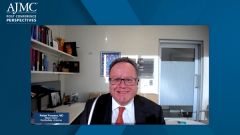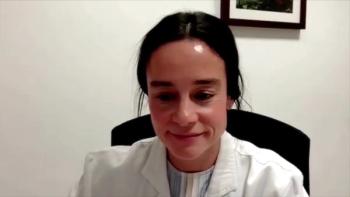
The MASTER Trial: Frontline Dara-KRd in Newly Diagnosed Multiple Myeloma
Expert perspective on results from the MASTER trial, which analyzed dara-KRd as frontline therapy with MRD-adapted use in newly diagnosed multiple myeloma.
Episodes in this series

Transcript:
Rafael Fonseca, MD: At the 2021 American Society of Hematology [ASH] meeting, we had an opportunity to see an update on the MASTER trial. The MASTER trial, which was presented and lead by Dr Luciano Costa [Luciano Costa, MD, PhD], addresses the ability to have deep control of multiple myeloma by using the combination of daratumumab [Darzalex®], carfilzomib [Kyprolis®], lenalidomide [Revlimid®], and dexamethasone [KRd] followed by stem cell transplant and then followed by more treatment of the same with a caveat that this is one of the first trials that asked the question if patients in such a trial are able to have sustained MRD [minimal residual disease] negativity, can they go on and discontinue therapy? The primary report deals with the depth of the response rate, which was the primary objective of the clinical trial, and the results continue to be excellent.
I saw the data being presented for the MASTER trial. A few things stood out. First, a large fraction of patients are able to achieve MRD negativity. It all depends on what type and for what subset of patients you ask this question. But up to 80% of patients can achieve MRD negativity at the threshold of 10-5. If one uses a more stringent restful of 10-6, you see that again up to 60% of patients are able to achieve this very profound depth of response. That was number 1. One of the things that Dr Costa did for this presentation was break it down by risk classification. He looked at patients who had no high-risk factors, 1 high-risk factor, or 2 or more. At first glance, the depth of their response was not that different. If you look at patients who have either none or just 1 high-risk marker, the results are very good when it comes down to progression-free survival [PFS]. We still see an effect of high-risk markers. Even patients who are able to become negative. But when you take the group at large, the results present an unprecedented ability to have upfront control of transplant eligible multiple myeloma.
Over the last several years, we have seen more and more that utilization of MRD will be of critical importance for the clinical practice and for the understanding of the level of responses that we’re achieving with our patients. Historically, I would have told you that it’s important to understand it, but not necessarily measure it. Now I would argue that in 2031 this should be an integral part of modern myeloma treatment centers. Patients who can achieve such levels of response at the minimum, can be counseled and can be told about the better outcomes they have when they can reach that stage. That would be very important. Of course, these trials addressing other questions, such as what fraction of patients are able to sustain that even in the absence of continued treatment, which is a critically important question because historically with treating myeloma for years and years, for instance, with maintenance sometimes for a long period of time. We are hoping that through the use of technology such as MRD, we can stop treatment. Now, the next point for me is that seeing this very high level of responses and seeing also that a regimen like daratumumab-KRdis considering the NCCN [National Comprehensive Cancer Network] guidelines that will strive to have the majority of my patients have this as free light therapy for their disease.
A very interesting and often underappreciated aspect of measuring MRD, is that it can be good for everyone. It can be good for the patient if A, you are able to achieve a level of response that will translate into durable disease control, which ultimately would result in decrease health care utilization. It’s also good that if we have a situation where a patient has sustained MRD negativity, and we see that that endures despite stopping treatment, we might be able to stop therapy earlier than what we currently do. If you think of this from the perspective of a payer, when one thinks of a regimen like dara- [daratumumab]-KRd [ carfilzomib, lenalidomide, dexamethasone] the unit price of the drugs potentially could be argued to be high. However, what we need to [do is] start looking more and more at the total cost of care from the beginning all the way to completion of therapy. Nowadays, we have patients who are in chronic therapy like chronic maintenance with lenalidomide, as is the standard of care. I bring this information into the conversation with patients as we’re pondering whether someone should continue therapy or not. There’s a common mistake to think of MRD as the sole and only determinant of that decision, and that is wrong. MRD is simply one more piece of information that makes you have a more sophisticated and more informed conversation with the patient. For example, if I were to have a patient who has sustained MRD negativity, but who’s experiencing a significant burden from the adverse effects of maintenance, I would be more inclined to provide a recommendation that we stopped treatment, which we often do on the basis of symptoms alone. Another example, the other extreme, could be someone who still remains positive, where there is concern of residual disease and yet the patient discovered in the treatment very well, but that bit of information may allow us to make a decision and say perhaps it seems better to continue in therapy. Again, this is just one more piece of information. This is a piece of information like we use the free light chains, like we use a protein electric freezes, imaging, and even our physical examination. But arguably, this is the most sensitive way to go about measuring residual myeloma. Again, it’s the best way to have a very sophisticated conversation with our patients.
Transcript edited for clarity.
Newsletter
Stay ahead of policy, cost, and value—subscribe to AJMC for expert insights at the intersection of clinical care and health economics.










